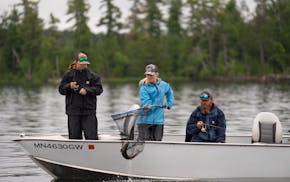Acting on a tip, Duluth fisheries biologists launched their boat into Lake Superior last fall and motored to a hidden corner of the Minnesota shoreline. There, they dipped the boat's electrofishing gear into the water, sending out a pulse just strong enough to stun a fish to the surface but not to kill or harm it. Then they saw it, floating in the water: spawning brook trout.
"It's incredible," said Cory Goldsworthy, the Lake Superior fisheries supervisor for the Minnesota Department of Natural Resources. "It has never been documented outside of Isle Royale to have shore-spawning brook trout in Lake Superior."
Biologists and fishery managers have been trying to restore the lake's brook trout — also called coaster trout — for decades. The fish typically spawn in Superior's tributaries, in places such as the Knife River and in the little creeks and streams along the North Shore. Once spawning season is over, they swim back out into the open waters of the great lake.
There had only been two known small populations of brook trout that lived all their days and spawned in the lake itself. Both live along the rocky and unique shoreline of Isle Royale, the remote island that is more than 15 miles from Minnesota's shore. One of those populations is artificially propped up and stocked every year. The other is wild.
Until the discovery, it wasn't even certain that the fish could spawn on Minnesota's shore, Goldsworthy said.
Now that they're here, it may be a sign that the once bountiful species is finally coming back.
"Lake Superior is cold," Goldsworthy said. "The fish don't grow real fast. So sometimes it takes generation after generation of conservation work to get results. This really could be, you know, the initial results of the last 40 years of brook trout conservation work."
Lake Superior's brook trout are big. So big that for nearly a century, until genetic testing, most people assumed they weren't brook trout at all but a species unique to the lake.
The average brook trout in Minnesota grows to about 8 inches. It's not uncommon for Superior's to grow to more than three times that size.
They were so plentiful in the early years of Minnesota's statehood that the trout sustained small villages on the North Shore and on Isle Royale.
"It used to be an incredible fishery," Goldsworthy said. "Into the 1850s and 1860s we have newspaper reports of people from Duluth coming up in little Mackinaw skiffs catching 200 brook trout in the mouth of the Knife River."
They were fished almost to death. Loggers clear-cut the forests around the once clear and cold rivers and streams where many of the trout spawned. Without the shade, or natural river banks, those spawning grounds were worthless to trout.
By the early 1900s, the fish were almost entirely gone from Superior.
Since 1997, the state has been trying to bring them back throughout the North Shore. Most of the restoration work has centered on known spawning creeks and streams, replacing culverts and restoring and protecting older forests.
Goldsworthy and the DNR are keeping the exact location of the shore-spawning trout a secret, to protect the small population from being targeted by anglers until it proves to be sustainable. They were discovered in October, the height of their spawning season.
The big question is where these fish came from. The DNR is in the process of testing the population's genetics.
The most likely scenario, Goldsworthy said, is that they swam to Minnesota shores from Isle Royale.
Brook trout typically keep to the shallows and hug the Isle Royale shoreline. It would be odd, but it's possible a few of those trout took the treacherous deep-water journey to find new spawning grounds, he said.
Another possibility is that brook trout native to Minnesota somehow learned to spawn in the lake, rather than a river.
"If that's the case then it tells us that these things are finding spawning habitat wherever it's available," Goldsworthy said.
In either scenario, the discovery opens up new options and hopes for fishery managers, anglers and conservationists. That could include more focused rehabilitation work on Minnesota's shoreline, or new stocking programs.
"One thing I do know is if you put a 24-inch brook trout in the hands of an angler, you will have much, much more support for the conservation of that fish," Goldsworthy said.
The DNR will start doing more survey work this October to see if it can find more populations of lake-spawning trout.

Why now might be the best time to make a deal on boats, ATVs and other powersports
Lupine is starting to bloom in Minnesota. Here's where to find it.

Xcel lets loose a small army of hungry sheep to keep its solar farm in order

Anderson: In early June, Minnesota fish are begging to be caught. Won't you help?
